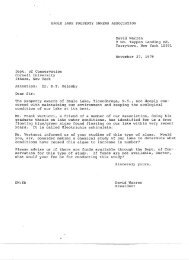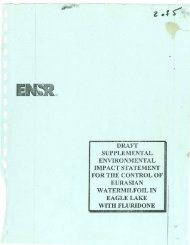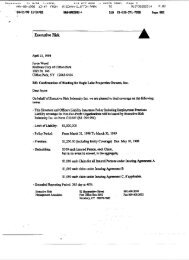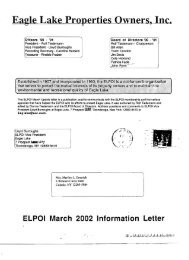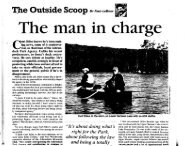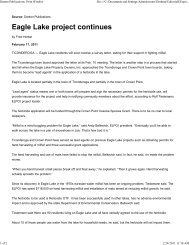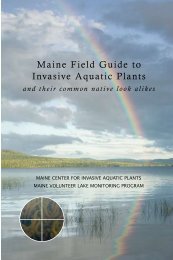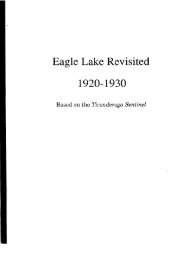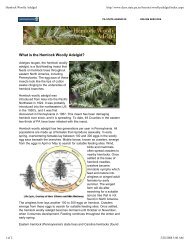Adirondack Park - Eagle Lake Property Owner's Inc.
Adirondack Park - Eagle Lake Property Owner's Inc.
Adirondack Park - Eagle Lake Property Owner's Inc.
Create successful ePaper yourself
Turn your PDF publications into a flip-book with our unique Google optimized e-Paper software.
II.<br />
Introduction<br />
The <strong>Adirondack</strong> <strong>Park</strong> Aquatic Nuisance Species Management Plan (the Plan) facilitates the<br />
coordination of aquatic nuisance species (ANS) management efforts throughout the <strong>Park</strong>. The<br />
Plan was developed with close attention to the New York State ANS Management Plan. The Plan<br />
also complements ANS efforts already underway in the eastern portion of the <strong>Park</strong> as part of the<br />
<strong>Lake</strong> Champlain Basin ANS Management Plan and is intended to coordinate closely with the<br />
<strong>Lake</strong> Champlain Basin Program (LCBP) to help fulfill its ANS management objectives. The<br />
<strong>Adirondack</strong> <strong>Park</strong> Aquatic Nuisance Species Management Plan identifies ANS problems and<br />
concerns, and describes specific objectives, strategies, and actions to be undertaken to manage<br />
aquatic nuisance species within the <strong>Park</strong>. The objectives, strategies, and actions described in<br />
Section V of the Plan specifically address the strategic ANS management approaches articulated<br />
by the New York State Invasive Species Task Force: education, prevention, early detection, rapid<br />
response, and control/management. Though the Plan is specific to the <strong>Adirondack</strong> <strong>Park</strong>, given<br />
the connectivity of roads and waters with those outside the <strong>Park</strong> boundary, meeting the goals of<br />
the Plan will also require close coordination with ANS management efforts outside of the <strong>Park</strong>.<br />
<strong>Adirondack</strong> Waters<br />
The <strong>Adirondack</strong> <strong>Park</strong> is 5.8 million acres in size and covers approximately 25% of the total land<br />
area of New York State (Figure II.1). The <strong>Park</strong> contains 12 major watersheds ranging in size<br />
from 175,602 acres for the Grass River to 1,087,692 acres for the Upper Hudson River (Table<br />
II.1). These 12 watersheds drain in several directions, and are connected to <strong>Lake</strong> Ontario, the St<br />
Lawrence River, <strong>Lake</strong> Champlain, the Mohawk River, and the Lower Hudson River. The <strong>Park</strong><br />
contains 321,284 acres of surface water, which represents about 6% of the total land area. There<br />
are 11,076 lakes and ponds ranging from 0.01 acres to 28,511 acres (<strong>Lake</strong> George) in size<br />
(Figure II.2 and Table II.1). The Black River watershed contains the largest number of lakes and<br />
ponds at 2,705 followed by the Upper Hudson at 1,810 and Raquette River at 1,384. The<br />
Sacandaga River watershed contains the largest acreage of surface water at 103,148 acres<br />
followed by the Raquette River at 48,194 acres. The Sacandaga and Raquette River watersheds<br />
also have the highest surface density of water (acres of water per acre of land area). There are a<br />
total of 17,653 miles of rivers and streams greater than one mile in length. The Upper Hudson<br />
River watershed contains the greatest mileage of rivers and streams at 3,114 miles followed by<br />
the Black River watershed at 2,288 miles.<br />
The <strong>Adirondack</strong> <strong>Park</strong> contains 5,300 miles of public roads and 52 dams. A large number of<br />
lakes, ponds, and streams are located in close proximity to a public road (Figure II.3). There is<br />
considerable day use of <strong>Adirondack</strong> lakes each summer. For example, 1,160 boats were<br />
launched from the NYS DEC launch site on <strong>Lake</strong> Placid between Memorial Day and Labor Day<br />
in 2004 and 751 boats were launched into the St Regis lakes during the same period (PSCAWI<br />
Watershed Stewardship Program 2004 Report).<br />
The <strong>Adirondack</strong> <strong>Park</strong> contains 12 counties and 105 towns (Figure II.4). Only Essex and<br />
Hamilton Counties are contained wholly within the <strong>Park</strong> boundary. All of the boundaries for the<br />
12 watersheds cross over at least 2 counties and multiple towns. A close up example of this is<br />
shown for the Raquette River watershed, wherein the watershed contains parts of 4 counties (St<br />
2



